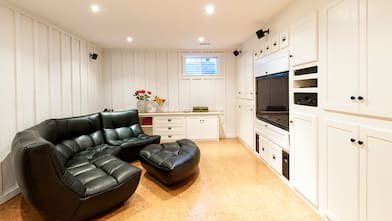Highlights
Natural light affects paint color as sunlight will reflect off the walls.
Consider factors like reflections from the outside when picking your paint color.
What direction the wall or room faces is also an important consideration.
A sunny room is the perfect opportunity to play around with color.
For rooms with little natural light, many homeowners default to white or neutral paint colors that give the illusion of more space—even though the right dark paint in a cozy room or lounge can also help achieve a certain mood. But the right paint color is only the first step; you need lighting to complement it.
Here’s what you need to know to make the most of your space with color and light.
How Does Natural Light Affect Paint Color?
The impact of the sun reflecting off of grass or your neighbor’s wall can completely alter the reality of your paint chip choice. You need to take into consideration the hues and shades of varying ranges of colors that reflect back into the belly of your home by painting large swatches on the wall (about a 2-by-2-foot area) before committing to a paint color.
What Should I Consider When Choosing a Paint Color?
Picking the perfect paint color for your house can often feel overwhelming, particularly if you’re building a new space that doesn’t already have lighting, flooring, and other accents to build on. Bold, electric hues do well in brightly lit rooms, but neutral paint colors also set a certain kind of tone especially if your furniture is going to make a statement.
If you know what to look for when painting a room with lots of natural light, it will help narrow down the options for you. But no matter what direction you take, you should always give yourself a few days or even a week after you paint your test swatches on the wall to observe the colors in varying times of day before fully committing.
The factors below will alter how a paint color looks in a specific space.
The Direction the Room Faces
North-facing rooms trend toward moodiness because they’re shrouded in darkness most of the year. Picking a paint like a lime green or Dutch orange that lends a bright pop of color will help lift the spirit of the space. On the flip side, leaning into a darker mood is also advantageous, with taupes, grays, and deep browns enhancing walls that face north.
Rooms with walls that face the sun are oriented toward the south-easterly direction and are great spots to go big with color and indoor foliage. It’s also a great location to use neutrals and shades of white to further lighten up the mood, using live greenery as the accents for the space.
Eastern- and western-facing walls provide spaces for alternating moods throughout the day and are especially important surfaces to test out sample colors. The range of variations from the natural changing of light direction is immense.
The Color of the Floors
The color of your floors will influence how your finished wall colors look. If your home is draped in the shade of red or honey-colored hardwood commonly found in American homes, it will dramatically alter neutral colors and whites as the light shines in.
Deeper browns and black found in walnut-colored wood are less intrusive to changing how the colors will change, but results will vary depending on the angle of the sun. Bolder colors tend to not be influenced by floor color because they reflect less light.
The Room’s Lighting
Lighting choices, such as a broad spectrum bulb or narrow and pinpointed affairs, do have the opportunity to affect how the colors look during different times of day. Taking the time to paint broad swatches throughout the room where you intend to paint is a good way to mitigate potential design faux pas that require a reboot.
The Reflections From the Outside
One major factor a lot of homeowners forget to include in their interior painting plans: how the colors outside affect the colors inside.
If you live near an open body of water, blues, grays, and greens will alter any neutral or white choices. If you have an expansive lawn, these reflections will input dark greens during the growing months and light shades of tan or brown in the winter. Hardscaping, which includes any concrete or stone slabs, also has the potential to inject pinks and tans into your room’s equation.
Any Existing Cabinetry
If you have any cabinetry in the room you’re painting, you’ll also want to take those colors into consideration when choosing a paint color. In general, darker trim bodes well for pastels, neutrals, and white colors while lighter trim is a nice accent for rich, extravagant choices, particularly with single walls.
Are Dark or Light Paint Colors Better for a Room With Natural Light?
For rooms with little natural light, stick to a more narrow palette of white or beige paint. That is, unless you’re into a cavernous look, which can be an excuse to play around with deep velvet greens and blue. So, if you’re a fan of bold choices and utilizing color, a room with a lot of natural light is a great opportunity to embrace your most exuberant palette.
Dark interior paint colors can make a room feel closed off in certain circumstances, but they can also add drama, depth, and open up the room by creating a visual dead zone. If you have little natural light, consider classic billiard room colors like dark green, red, or blues as your accent wall colors.
And remember: The perfect paint color is the one that is going to bring you and your family joy, so at the end of the day, if that’s white, black, magenta, or eggplant purple, go with your gut. You can also hire a local interior designer to come up with a few different options and show you how they look in your actual space using 3D modeling.
What Color Should I Paint a Sunny Room?
Having a sunny room offers you so many options when it comes to painting your walls. You could paint the entire room in a deep paint color, then punctuate it with antiques and house plants. Or, you could go for a lighter paint like a white or beige and use a bright paint for an accent wall.
Another option for your room with natural light like a kitchen is to paint the cabinets a fun paint color, then stick to white, gray, or other neutral tones for the walls.
Should I Hire a Professional or DIY My Paint Job?

Painting is one of those common house tasks that most homeowners will attempt at least once in their lives. The great thing about paint is that it’s not permanent, so if you don’t like the initial color or outcome, you can always cover it up with a different choice down the line.
Keep these home painting tips in mind as you proceed with your paint project, and if it all just seems too overwhelming, then consider bringing in a professional local painter to tackle the room for you.




